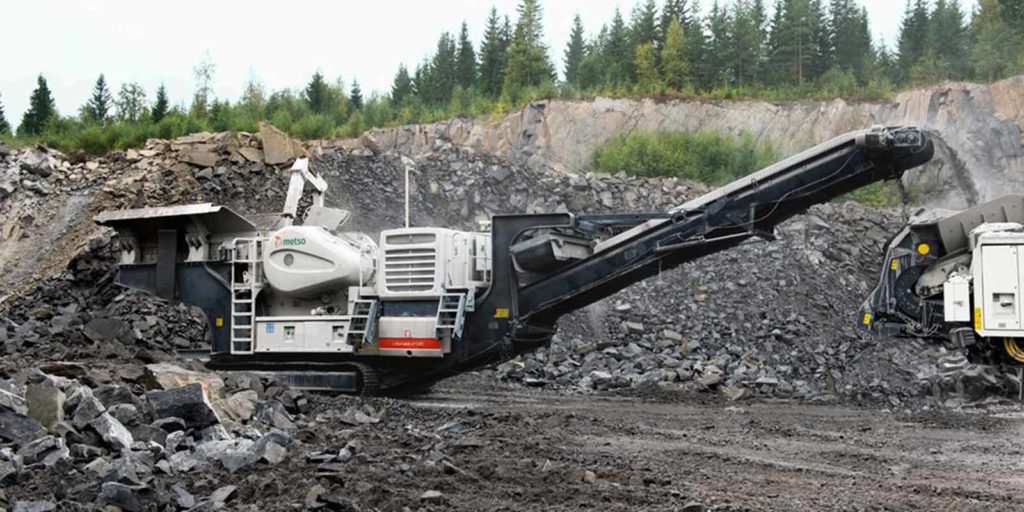Crushing equipment is most often used in the processing of virgin materials – of limestone, basalt, granite, or other stone that’s mined. Consequently, when you think of rock crushing, that’s probably the type of crushing that comes to mind. But crushing equipment is just as useful in the recycling of materials as it is in their original crushing. In fact, crushing equipment is what enables the effective recycling of materials like concrete and asphalt. At Mellott, we’re proud to see our equipment put to innovative use in material recycling. Here’s a look at the industry around concrete and asphalt recycling – and a look at how this growing trend is made possible by Mellott equipment.
Traditional Concrete and Asphalt Disposal
Traditionally, materials like asphalt and concrete were relegated to landfills upon removal. After being removed from parking lots or construction sites, they’d simply be transported to the nearest landfill for disposal. The approach, while simple, still resulted in freight costs, and, obviously, in landfill sites that were filled more quickly.
Recycling changed that by enabling materials to be reused. However, in the early days of recycling, reuse was almost solely as fill product, due to issues of quality and gradation irregularity.
Today, however, recycled concrete and asphalt can be crushed into forms that are usable in a breadth of industry applications.
How Concrete and Asphalt Recycling Work Today
Concrete Recycling
Concrete recycling entails breaking, removing, and crushing concrete into a material of a specified size and quality – not unlike the processes of crushing virgin materials. Demolished sidewalks, building columns, or foundations are broken up and compiled. The concrete can either be hauled to a recycling site for crushing, or (often more cost-effectively) crushed on-site using a portable crushing rig.
Advances in crushing equipment and technology have enabled more comprehensive crushing of a broader range of concretes. Steel remnants are now removed with less manual labor, and materials ranging from jointed plain pavement, to jointed reinforced pavement, to continuously reinforced pavement, can all be crushed given the appropriate equipment.
Once crushed to specifications, recycled concrete material is put to use. While it’s often still used as subbase, it can also be used as an aggregate for new concrete – although, in that case, it’s often combined with virgin material aggregate as well.
Asphalt Recycling
Asphalt recycling is increasingly common; according to the Federal Highway Administration, over 80% of asphalt removed from roads is recycled. And that’s partly due to its functionality – the FHA also asserts that:
“Recycled asphalt product is now routinely accepted in asphalt paving mixtures as an aggregate substitute and as a portion of the binder in nearly all 50 states. Recently developed technology has even made it possible to recycle 90 to 100 percent recycled asphalt product in hot mix.”
The process is, again, similar to traditional crushing processes: asphalt is broken, removed from parking lots and roads, and then hauled to locations where it’s chipped and stockpiled. In its crushed form, it’s often used as a chalk mix to replace what’s been removed.
The Limitations of Recycling Concrete and Asphalt
While recycling has improved over the past few decades in terms of material functionality, there remain a few limitations.
First, while the gradation control of recycled materials compares favorably to the gradation quality of virgin materials, abrasion does tend to be different. Additionally, there have been prior instances of contaminants found in recycled materials – although today, with adherence to proper processes and the use of improved technologies, this is very unlikely.
The Benefits of Recycling Concrete and Asphalt
The substantial benefits of recycling offset its limitations, though. There are two main reasons to recycle concrete and asphalt. The first is efficiency – often, the cost to recycle material is less than the cost of disposing of material in a landfill. That, coupled with the cost savings on the use of recycled material, makes recycling an economically appealing option.
Secondly, recycling is more environmentally friendly. Not only does recycling reduce the amount of material that ends up in landfills, but it can also reduce transportation mileage, especially if crushing is done onsite via a portable crusher.
Lastly, using recycled materials extends the life of natural reserves. This assists in providing natural resources for tomorrow by recycling today.
Trends in Concrete and Asphalt Recycling
So, what does the future hold for concrete and asphalt recycling? Put simply: probably more of it.
More and more recycled material is being used, and its usage is increasingly being broadened into applications traditionally reserved for virgin material. As the quality of recycled materials improves, so does the legislative pressure to use them. In New Jersey, for instance, there’s a mandate that forbids any recyclable materials from being disposed of in landfills. Asphalt and concrete, consequently, are nearly always recycled.
The Role of Mellott
At Mellott, we’re excited for our crushing equipment to continue contributing to the growth of concrete and asphalt recycling. Our crushers are used in recycling by companies like Tilcon, enabling them to service the reuse of materials in ways that weren’t previously possible, and provide premiere concrete and asphalt recycling services.
Because in recycling, as it does in all of our crushing activities, our focus on safety, integrity, commitment, respect and excellence holds true.
To learn more about our crushing equipment, or to get a quote on equipment for your crushing needs, get in touch with us online or at 855.554.1606.

